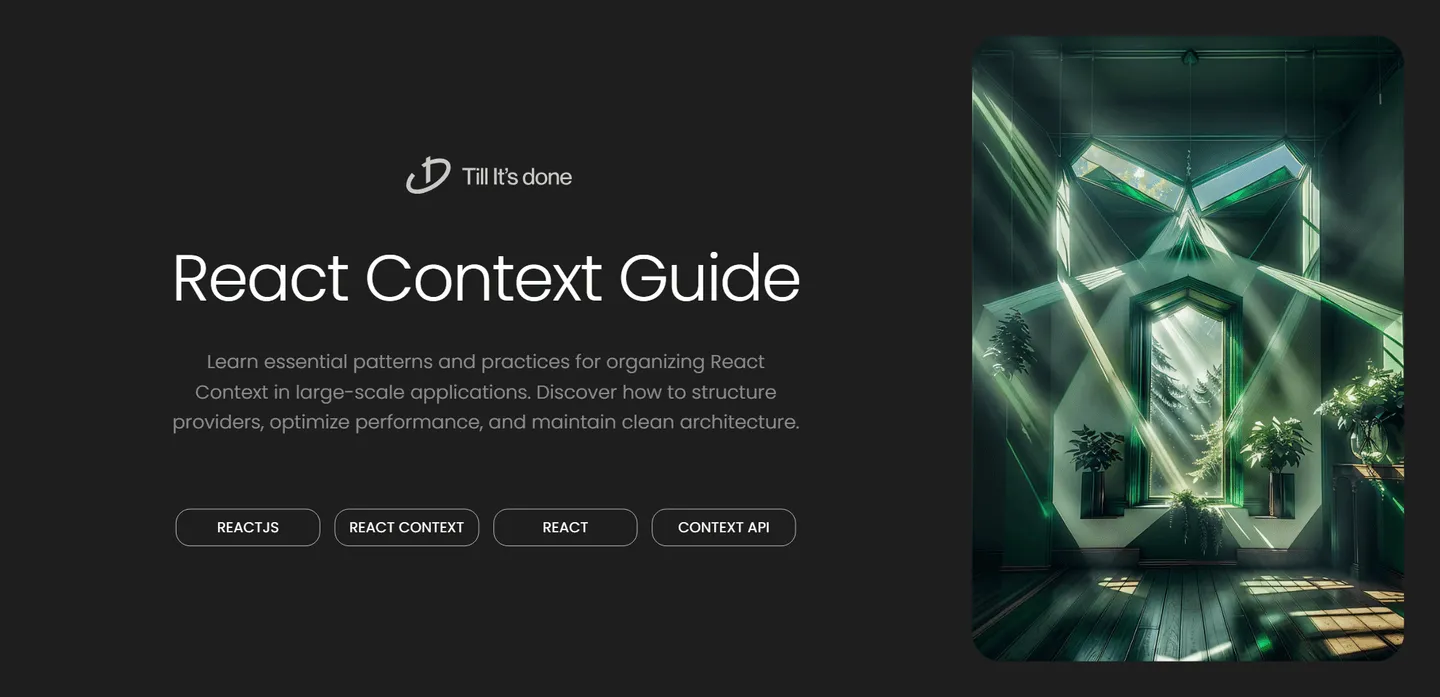- Services
- Case Studies
- Technologies
- NextJs development
- Flutter development
- NodeJs development
- ReactJs development
- About
- Contact
- Tools
- Blogs
- FAQ
Best Practices for React Context in Large Apps
Discover how to structure providers, optimize performance, and maintain clean architecture.

Best Practices for Structuring React Context in Large Apps

As React applications grow larger and more complex, managing state effectively becomes increasingly crucial. React Context, while powerful, can quickly become unwieldy without proper organization. Let’s explore battle-tested patterns and best practices for structuring Context in large-scale applications.
The Problem with Unstructured Context
Many developers start by creating a single, large context provider that holds all shared state. While this works for smaller apps, it quickly becomes a maintenance nightmare in larger applications. The issues include:
- Poor code organization
- Unnecessary re-renders
- Difficult testing
- Reduced code reusability

Context Composition Pattern
Instead of one massive context, break your application state into logical, focused contexts. Think of them as specialized services, each handling a specific concern:
// Authentication Contextconst AuthContext = createContext<AuthContextType | undefined>(undefined);
// Theme Contextconst ThemeContext = createContext<ThemeContextType | undefined>(undefined);
// User Preferences Contextconst PreferencesContext = createContext<PreferencesContextType | undefined>(undefined);Context Provider Organization
Create a clean hierarchy of providers, starting with the most fundamental ones:
function AppProviders({ children }) { return ( <AuthProvider> <ThemeProvider> <PreferencesProvider> {children} </PreferencesProvider> </ThemeProvider> </AuthProvider> );}
Best Practices
- Create Custom Hooks Instead of directly using useContext, create custom hooks that handle the context consumption logic:
function useAuth() { const context = useContext(AuthContext); if (context === undefined) { throw new Error('useAuth must be used within an AuthProvider'); } return context;}- Separate Context Logic Keep your context-related code organized in dedicated folders:
src/ contexts/ auth/ AuthContext.tsx AuthProvider.tsx useAuth.ts types.ts theme/ ThemeContext.tsx ThemeProvider.tsx useTheme.ts types.ts- Optimize for Performance Use context splitting and memoization to prevent unnecessary re-renders:
const MemoizedThemeProvider = memo(ThemeProvider);const MemoizedUserPreferences = memo(PreferencesProvider);- Type Safety Leverage TypeScript to ensure type safety across your context usage:
interface AuthContextType { user: User | null; login: (credentials: Credentials) => Promise<void>; logout: () => Promise<void>;}Advanced Patterns
Context Composition with Reducers
For complex state management, combine Context with reducers:
const [state, dispatch] = useReducer(authReducer, initialState);return ( <AuthContext.Provider value={{ state, dispatch }}> {children} </AuthContext.Provider>);Context Selectors
Implement selector patterns to access specific parts of context state:
function useUserRole() { const { state } = useAuth(); return state.user?.role;}Remember, the key to successful Context implementation in large applications is maintaining separation of concerns and following consistent patterns throughout your codebase. Start with these practices early in your project to ensure scalability and maintainability as your application grows.

 สร้างเว็บไซต์ 1 เว็บ ต้องใช้งบเท่าไหร่? เจาะลึกทุกองค์ประกอบ website development cost อยากสร้างเว็บไซต์แต่ไม่มั่นใจในเรื่องของงบประมาณ อ่านสรุปเจาะลึกตั้งแต่ดีไซน์, ฟังก์ชัน และการดูแล พร้อมตัวอย่างงบจริงจาก Till it’s done ที่แผนชัด งบไม่บานปลายแน่นอน
สร้างเว็บไซต์ 1 เว็บ ต้องใช้งบเท่าไหร่? เจาะลึกทุกองค์ประกอบ website development cost อยากสร้างเว็บไซต์แต่ไม่มั่นใจในเรื่องของงบประมาณ อ่านสรุปเจาะลึกตั้งแต่ดีไซน์, ฟังก์ชัน และการดูแล พร้อมตัวอย่างงบจริงจาก Till it’s done ที่แผนชัด งบไม่บานปลายแน่นอน  Next.js สอน 14 ขั้นตอนเบื้องต้น: สร้างโปรเจกต์แรกใน 30 นาที เริ่มต้นกับ Next.js ใน 14 ขั้นตอนเพียงแค่ 30 นาที พร้อม SSR/SSG และ API Routes ด้วยตัวอย่างโค้ดง่าย ๆ อ่านต่อเพื่อสร้างโปรเจ็กต์แรกได้ทันทีที่นี่
Next.js สอน 14 ขั้นตอนเบื้องต้น: สร้างโปรเจกต์แรกใน 30 นาที เริ่มต้นกับ Next.js ใน 14 ขั้นตอนเพียงแค่ 30 นาที พร้อม SSR/SSG และ API Routes ด้วยตัวอย่างโค้ดง่าย ๆ อ่านต่อเพื่อสร้างโปรเจ็กต์แรกได้ทันทีที่นี่  วิธีสมัคร Apple Developer Account เพื่อนำแอปขึ้น App Store ทีละขั้นตอน อยากปล่อยแอปบน App Store ระดับโลก มาอ่านคู่มือสมัคร Apple Developer Account พร้อมเคล็ดลับ TestFlight และวิธีอัปโหลดที่ง่ายในบทความเดียวนี้ได้เลย
วิธีสมัคร Apple Developer Account เพื่อนำแอปขึ้น App Store ทีละขั้นตอน อยากปล่อยแอปบน App Store ระดับโลก มาอ่านคู่มือสมัคร Apple Developer Account พร้อมเคล็ดลับ TestFlight และวิธีอัปโหลดที่ง่ายในบทความเดียวนี้ได้เลย  TypeScript Interface คืออะไร? อธิบายพร้อมวิธีใช้และข้อแตกต่างจาก Type เรียนรู้วิธีใช้ TypeScript Interface เพื่อสร้างโครงสร้างข้อมูลที่ปลอดภัยและเข้าใจง่าย พร้อมเปรียบเทียบข้อดีข้อแตกต่างกับ Type ที่คุณต้องรู้ ถูกรวมเอาไว้ในบทความนี้แล้ว
TypeScript Interface คืออะไร? อธิบายพร้อมวิธีใช้และข้อแตกต่างจาก Type เรียนรู้วิธีใช้ TypeScript Interface เพื่อสร้างโครงสร้างข้อมูลที่ปลอดภัยและเข้าใจง่าย พร้อมเปรียบเทียบข้อดีข้อแตกต่างกับ Type ที่คุณต้องรู้ ถูกรวมเอาไว้ในบทความนี้แล้ว  Material-UI (MUI) คืออะไร อยากสร้าง UI สวยงามและเป็นมืออาชีพในเวลาอันรวดเร็วใช่ไหม มาทำความรู้จักกับ Material-UI (MUI) ที่ช่วยให้คุณพัฒนาแอปพลิเคชันบน React ได้ง่ายและดูดีในทุกอุปกรณ์
Material-UI (MUI) คืออะไร อยากสร้าง UI สวยงามและเป็นมืออาชีพในเวลาอันรวดเร็วใช่ไหม มาทำความรู้จักกับ Material-UI (MUI) ที่ช่วยให้คุณพัฒนาแอปพลิเคชันบน React ได้ง่ายและดูดีในทุกอุปกรณ์  เปรียบเทียบ 3 วิธีติดตั้ง install node js บน Ubuntu: NVM vs NodeSource vs Official Repo แบบไหนดีที่สุด? เรียนรู้วิธีติดตั้ง Node.js บน Ubuntu ด้วย NVM, NodeSource หรือ Official Repo เลือกวิธีที่เหมาะกับความต้องการของคุณ พร้อมเปรียบเทียบ เพื่อการพัฒนาที่มีประสิทธิภาพ!
เปรียบเทียบ 3 วิธีติดตั้ง install node js บน Ubuntu: NVM vs NodeSource vs Official Repo แบบไหนดีที่สุด? เรียนรู้วิธีติดตั้ง Node.js บน Ubuntu ด้วย NVM, NodeSource หรือ Official Repo เลือกวิธีที่เหมาะกับความต้องการของคุณ พร้อมเปรียบเทียบ เพื่อการพัฒนาที่มีประสิทธิภาพ! พูดคุยกับซีอีโอ
We'll be right here with you every step of the way.
We'll be here, prepared to commence this promising collaboration.
Whether you're curious about features, warranties, or shopping policies, we provide comprehensive answers to assist you.


